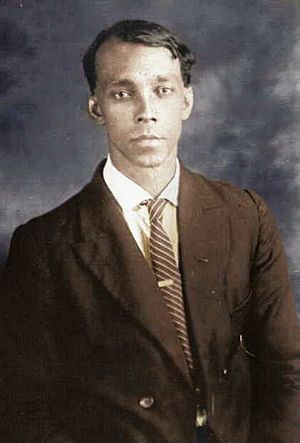Brass Ankles facts for kids

Piney Jackson aka Julius Amaker
|
|
| Regions with significant populations | |
|---|---|
| Holly Hill, South Carolina, eastern United States | |
| Languages | |
| English | |
| Religion | |
| Predominantly Baptist | |
| Related ethnic groups | |
| Melungeon, Lumbee Indians, Beaver Creek Indians, Louisiana Creole people |
The Brass Ankles are a group of people from South Carolina. They were also sometimes called Croatan. They lived in swampy areas near Goose Creek and Holly Hill (especially a place called Crane Pond). They moved to these areas to escape unfair treatment and the Indian Removal Act, which forced many Native Americans from their homes.
In these swamp areas, African slaves and European indentured servants found safety with Native American groups. Together, they formed strong and successful communities. Many Brass Ankles today are direct descendants of Robert Sweat and Margarate Cornish.
Contents
Life After the Civil War
Even though many of these mixed-race people were free before the American Civil War, things changed after the war ended. During a time called Reconstruction, white politicians from the Democratic Party took back power in the Southern states. They created strict laws known as Jim Crow laws. These laws enforced racial segregation, meaning people of different races were kept separate. They also promoted the idea of white supremacy, which said that white people were better than others.
How People Were Classified
For a long time, the United States Census (a count of the population) had a category called "mulatto" for people of mixed Black and white ancestry. But in 1930, powerful politicians from the South changed the rules. They made it so people could only be classified as either Black or white.
Most Southern states also passed laws based on the "one-drop rule". This rule meant that if a person had any known Black ancestor, even just "one drop" of Black ancestry, they were officially classified as Black. This rule ignored if someone had Native American or white ancestors too.
Many people who had always been known as "Indian" or mixed-race were now forced to choose between being classified as Black or white. However, many Brass Ankles continued to identify themselves as Croatan on important documents like death certificates.
Common Family Names
Records from the 1910 Holly Hill, SC Census show many common family names among the Brass Ankles. These include Weatherford, Platt, Pye, Jackson, Chavis, Bunch, Driggers, Sweat (sometimes spelled Swett), Williams, Russell, Scott, Wilder, and Goins.
Some of these names are also found among other mixed-race groups, like the Melungeon people in Tennessee and the Lumbee people in North Carolina. Over time, some mixed-race families joined and married into larger groups, becoming part of white, Black, or even the Beaver Creek Indians communities. Some Sweat, Chavis, and Driggers families moved from the Marlboro County, South Carolina area in the early 1800s.
The Crane Pond Community
Many mixed-race people lived in a part of Orangeburg County near Holly Hill called Crane Pond. The name "Brass Ankles" was often used for people of mixed ancestry in this area. Many of them had a large amount of white ancestry and might have been considered legally white in the early 1800s. The Crane Pond community has kept its unique culture and traditions alive for many years. There are many local stories about where these people came from, showing their diverse family backgrounds.
Official Recognition
In 2005, the state of South Carolina officially recognized five Native American tribes. Some people who were once called "Brass Ankles" have ancestors who are now part of these recognized tribes, such as the Wassamasaw Tribe of Varnertown Indians.
Because members of these tribes often had multiracial backgrounds, including African ancestors, their white neighbors sometimes didn't understand their Native American culture. Census takers, who were mostly focused on African ancestry, often incorrectly classified them as "mulatto". After 1930, when the "mulatto" category was removed from the US census, these multiracial people were often classified as Black in the South. This was because anyone who looked "of color" was often put into the Black category.
Census Records and Culture
It's important to know that the "Indian" category was available on every US census throughout the 1800s. However, census takers often only used this category for people living on Indian reservations or those who clearly showed what the census takers thought was "Indian" culture. People who seemed to live like the majority culture were usually classified as white, Black, or mulatto, depending on their appearance and their neighbors' appearance.
Dubose Heyward, who wrote the famous story Porgy and Bess, also wrote a play about the Brass Ankles. His play was set right after the Civil War.
Schools for Brass Ankle Children
Some Brass Ankles in the community of Summerville, South Carolina called themselves "Summerville Indians." In the early 1900s, public schools were separated for white or Black students. The Summerville Indians and other Brass Ankle groups got permission from the state to create their own separate schools for their Native American children. These families had been free long before the American Civil War and did not want their children to go to school with descendants of freed slaves. The Eureka "Ricka" school in Charleston County is an example of one of these special Indian schools.

